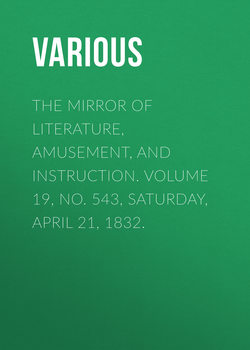Читать книгу The Mirror of Literature, Amusement, and Instruction. Volume 19, No. 543, Saturday, April 21, 1832. - Various - Страница 1
MELROSE ABBEY
Оглавление(From a finished sketch, by a Correspondent.)
These venerable ruins stand upon the southern bank of the Tweed, in Roxburghshire. The domestic buildings of the monastery are entirely gone; but the remains of the church connected with, as seen in the above Engraving, are described by Mr. Chambers1 as "the finest specimen of Gothic architecture and Gothic sculpture of which this country (Scotland) can boast. By singular good fortune, Melrose is also one of the most entire, as it is the most beautiful, of all the ecclesiastical ruins scattered throughout this reformed land. To say that it is beautiful, is to say nothing. It is exquisitely—splendidly lovely. It is an object of infinite grace and immeasurable charm; it is fine in its general aspect and in its minutest details; it is a study—a glory." We confess ourselves delighted with Mr. Chambers's well-directed enthusiasm.
A page of interesting facts towards the history of the Abbey will be found appended to the "Recollections" of a recent visit by one of our esteemed Correspondents, in The Mirror, vol. x., p. 445. In the present view, the ornate Gothic style of the building is seen to advantage, but more especially the richness of the windows, and the niches above them: the latter, from drawings made "early in the reign of King William," were originally filled with statues; and, connected with the destruction of some of them, Mr. Chambers relates the following anecdote "told by the person who shows Melrose:"
"On the eastern window of the church, there were formerly thirteen effigies, supposed to represent our Saviour and his apostles. These, harmless and beautiful as they were, happened to provoke the wrath of a praying weaver in Gattonside, who, in a moment of inspired zeal, went up one night by means of a ladder, and with a hammer and chisel, knocked off the heads and limbs of the figures. Next morning he made no scruple to publish the transaction, observing, with a great deal of exultation, to every person whom he met, that he had 'fairly stumpet thae vile paipist dirt nou!' The people sometimes catch up a remarkable word when uttered on a remarkable occasion by one of their number, and turn the utterer into ridicule, by attaching it to him as a nickname; and it is some consolation to think that this monster was therefore treated with the sobriquet of 'Stumpie,' and of course carried it about with him to his grave."
The exquisite beauty and elaborate ornament of Melrose can, according to the entertaining work already quoted, be told only in a volume of prose; but, as compression is the spirit of true poetry, we quote the following descriptive lines:
If thou would'st view fair Melrose aright,
Go visit it by the pale moonlight;
For the gay beams of lightsome day
Gild but to flout the ruins gray.
When the broken arches are dark in night,
And each shafted oriel glimmers white;
When the cold light's uncertain shower
Streams on the ruin'd central tower;
When buttress and buttress, alternately,
Seem framed of ebon and ivory;
Wnen silver edges the imagery,
And the scrolls that teach thee to live and die;
When distant Tweed is heard to rave,
And the howlet to hoot o'er the dead man's grave,
Then go—but go alone the while—
Then view St. David's2 ruined pile;
And, home returning, soothly swear,
Was never scene so sad and fair.
By a steel-clench'd postern door,
They enter'd now the chancel tall;
The darken'd roof rose high aloof
On pillars, lofty, light, and small;
The key-stone, that lock'd each ribbed aisle,
Was a fleur-de-lys or a quatre-feuille;
The corbells3 were carved grotesque and grim;
And the pillars, with cluster'd shafts so trim,
With base and capital furnish'd around,
Seem'd bundles of lances which garlands had bound.
The moon on the east oriel shone,
Through slender shafts of shapely stone,
By foliated tracery combined;
Thou would'st have thought some fairy's hand
'Twixt poplars straight the osier wand
In many a freakish knot had twined;
Then framed a spell, when the work was done,
And changed the willow-wreaths to stone.4
The monks of Melrose were caricatured for their sensuality at the Reformation. Their Abbey suffered in consequence; for the condemnator, out of the ruins, built himself a house, which may still be seen near the church. "The regality," says Mr. Chambers, "soon after passed into the hands of Lord Binning, an eminent lawyer, ancestor to the Earl of Haddington; and about a century ago, the whole became the property of the Buccleuch family."
1
Picture of Scotland, vol. i.
2
Built by David I. in 1136.
3
Corbells, the projections from which the arches spring, usually cut in a fantastic face, or mask.
4
Sir Walter Scott's "Lay of the Last Minstrel."
